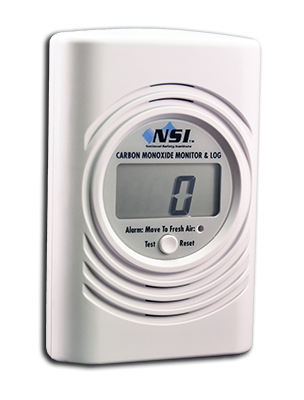National Comfort Institute (NCI) staff are often asked why we don’t sell the National Safety Instruments (NSI) 6000 Carbon Monoxide (CO) monitor directly to the public? The truth is that we could sell more monitors if we marketed and sold them directly to consumers. There are, however, some significant reasons why for nearly 20 years, we have chosen to only sell through trained professionals. To truly understand this, it’s essential to know the difference between a low-level CO monitor and a CO detector that you can purchase at any retail outlet.
Detector Versus Monitor
The average CO detector does not alarm until unsafe levels (70+ ppm) are present in a living space for up to 3½ hours. By then, you will already feel the effects of CO poisoning. What’s even scarier is if CO drops below 70 ppm, the alarm will reset for up to another 3½ hours! That means you could be living in an environment containing 69-70ppm of CO without the detector ever alarming.
At 70 ppm, people may start experiencing lightheadedness, nausea, or convulsions. These symptoms are even more severe in young children and the elderly. If there is an ambient 70 ppm level, residents should evacuate and shut the gas off. At that point, the trained contractor should test to find the exact source of the CO.
The NSI 6000 low-level CO monitor begins reading carbon monoxide at five ppm after 30 seconds. The first audible alert is at 15 ppm after five minutes of exposure. Is 15 ppm dangerous? The alarm is going off. Should you evacuate the home?
Professional Experts Who Teach Customers
That is where the NCI CO and Combustion certified technician comes in! NCI trains these techs to enter customers’ homes with the correct equipment to diagnose and pinpoint the CO source safely. They then correct the issue so the combustion appliance(s) will run safely going forward.
Educating the homeowner is the key to becoming that first line of defense against CO poisoning and that first phone call a customer makes. As a trained contractor, after first installing the NSI 6000 CO monitor, you should explain to customers the difference between a monitor and a detector. That discussion should include what the customer needs to do at each level of CO in the home if the situation arises. It’s also good to go over CO issues again during every maintenance visit. This is how contractors can become the customer’s resident CO expert — someone they know and trust for all their combustion appliance issues.
Fire Departments and Utilities: Not Usually Trained in CO
Most homeowners’ first instinct is to call the fire department or utility. Unfortunately, most fire department and utility personnel are not properly trained to deal with low CO levels, so many brush it off the alarms as a defective detector or a nuisance call. Meanwhile, the homeowner may live in high ambient CO levels in their home and are being slowly poisoned.
If NCI sells the NSI 6000 CO monitor direct, consumers lose the advantages of professional experts potentially uncovering dangerous CO issues in the home. Selling direct also poses a potentially significant uptick in “nuisance” calls to local fire departments not trained properly to handle low-level CO situations.
This is why National Comfort Institute created and only sells the NSI 6000 CO monitor to NCI-certified professionals. It is the best way to help keep customers safe and healthy.
Nick Guarino Nick joined NCI in July 2011 and is currently the Director of Sales and Operations. In that role he manages both the sales and operations teams. In addition, Nick sells private training classes, creates the monthly PowerPack, on-boards new members and has many other responsibilities. Prior to coming to NCI, Nick worked at Best Buy and FedEx, and also worked at a number of odd jobs including remodeling, demolition, and landscaping. You can contact him at ncilink.com/ContactMe.







Leave a Reply
You must be logged in to post a comment.